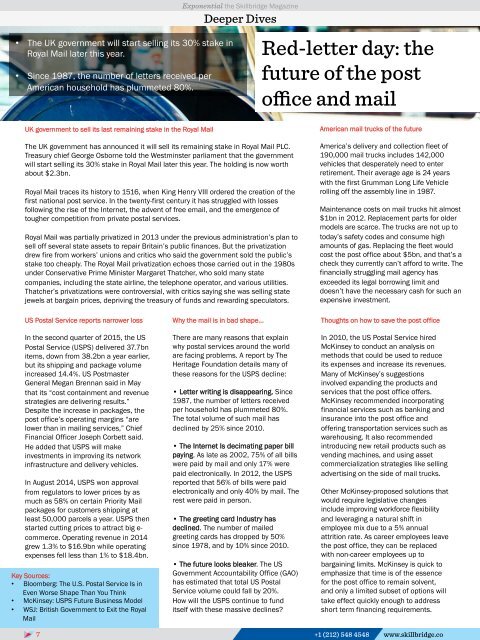Exponential -- June 14, 2015
In this issue, we discuss the global war for talent and the freelance platforms that are driving this talent revolution, South Korea's rapidly growing startup scene, the decline of the postal service, and why shipping firms must continue to innovate. We also feature an exclusive interview with Deb Cupp, SVP and General Manager for HR at SAP, who discusses how human resources solutions can be more seamlessly integrated into companies.
In this issue, we discuss the global war for talent and the freelance platforms that are driving this talent revolution, South Korea's rapidly growing startup scene, the decline of the postal service, and why shipping firms must continue to innovate. We also feature an exclusive interview with Deb Cupp, SVP and General Manager for HR at SAP, who discusses how human resources solutions can be more seamlessly integrated into companies.
You also want an ePaper? Increase the reach of your titles
YUMPU automatically turns print PDFs into web optimized ePapers that Google loves.
• The UK government will start selling its 30% stake in<br />
Royal Mail later this year.<br />
• Since 1987, the number of letters received per<br />
American household has plummeted 80%.<br />
<strong>Exponential</strong> the Skillbridge Magazine<br />
Deeper Dives<br />
Red-letter day: the<br />
future of the post<br />
office and mail<br />
UK government to sell its last remaining stake in the Royal Mail<br />
The UK government has announced it will sell its remaining stake in Royal Mail PLC.<br />
Treasury chief George Osborne told the Westminster parliament that the government<br />
will start selling its 30% stake in Royal Mail later this year. The holding is now worth<br />
about $2.3bn.<br />
Royal Mail traces its history to 1516, when King Henry VIII ordered the creation of the<br />
first national post service. In the twenty-first century it has struggled with losses<br />
following the rise of the Internet, the advent of free email, and the emergence of<br />
tougher competition from private postal services.<br />
Royal Mail was partially privatized in 2013 under the previous administration’s plan to<br />
sell off several state assets to repair Britain’s public finances. But the privatization<br />
drew fire from workers’ unions and critics who said the government sold the public’s<br />
stake too cheaply. The Royal Mail privatization echoes those carried out in the 1980s<br />
under Conservative Prime Minister Margaret Thatcher, who sold many state<br />
companies, including the state airline, the telephone operator, and various utilities.<br />
Thatcher’s privatizations were controversial, with critics saying she was selling state<br />
jewels at bargain prices, depriving the treasury of funds and rewarding speculators.<br />
American mail trucks of the future<br />
America’s delivery and collection fleet of<br />
190,000 mail trucks includes <strong>14</strong>2,000<br />
vehicles that desperately need to enter<br />
retirement. Their average age is 24 years<br />
with the first Grumman Long Life Vehicle<br />
rolling off the assembly line in 1987.<br />
Maintenance costs on mail trucks hit almost<br />
$1bn in 2012. Replacement parts for older<br />
models are scarce. The trucks are not up to<br />
today’s safety codes and consume high<br />
amounts of gas. Replacing the fleet would<br />
cost the post office about $5bn, and that’s a<br />
check they currently can’t afford to write. The<br />
financially struggling mail agency has<br />
exceeded its legal borrowing limit and<br />
doesn’t have the necessary cash for such an<br />
expensive investment.<br />
US Postal Service reports narrower loss<br />
In the second quarter of <strong>2015</strong>, the US<br />
Postal Service (USPS) delivered 37.7bn<br />
items, down from 38.2bn a year earlier,<br />
but its shipping and package volume<br />
increased <strong>14</strong>.4%. US Postmaster<br />
General Megan Brennan said in May<br />
that its “cost containment and revenue<br />
strategies are delivering results.”<br />
Despite the increase in packages, the<br />
post office’s operating margins “are<br />
lower than in mailing services,” Chief<br />
Financial Officer Joseph Corbett said.<br />
He added that USPS will make<br />
investments in improving its network<br />
infrastructure and delivery vehicles.<br />
In August 20<strong>14</strong>, USPS won approval<br />
from regulators to lower prices by as<br />
much as 58% on certain Priority Mail<br />
packages for customers shipping at<br />
least 50,000 parcels a year. USPS then<br />
started cutting prices to attract big e-<br />
commerce. Operating revenue in 20<strong>14</strong><br />
grew 1.3% to $16.9bn while operating<br />
expenses fell less than 1% to $18.4bn.<br />
Key Sources:<br />
• Bloomberg: The U.S. Postal Service Is in<br />
Even Worse Shape Than You Think<br />
• McKinsey: USPS Future Business Model<br />
• WSJ: British Government to Exit the Royal<br />
Mail<br />
Why the mail is in bad shape…<br />
There are many reasons that explain<br />
why postal services around the world<br />
are facing problems. A report by The<br />
Heritage Foundation details many of<br />
these reasons for the USPS decline:<br />
• Letter writing is disappearing. Since<br />
1987, the number of letters received<br />
per household has plummeted 80%.<br />
The total volume of such mail has<br />
declined by 25% since 2010.<br />
• The Internet Is decimating paper bill<br />
paying. As late as 2002, 75% of all bills<br />
were paid by mail and only 17% were<br />
paid electronically. In 2012, the USPS<br />
reported that 56% of bills were paid<br />
electronically and only 40% by mail. The<br />
rest were paid in person.<br />
• The greeting card Industry has<br />
declined. The number of mailed<br />
greeting cards has dropped by 50%<br />
since 1978, and by 10% since 2010.<br />
• The future looks bleaker. The US<br />
Government Accountability Office (GAO)<br />
has estimated that total US Postal<br />
Service volume could fall by 20%.<br />
How will the USPS continue to fund<br />
itself with these massive declines?<br />
Thoughts on how to save the post office<br />
In 2010, the US Postal Service hired<br />
McKinsey to conduct an analysis on<br />
methods that could be used to reduce<br />
its expenses and increase its revenues.<br />
Many of McKinsey’s suggestions<br />
involved expanding the products and<br />
services that the post office offers.<br />
McKinsey recommended incorporating<br />
financial services such as banking and<br />
insurance into the post office and<br />
offering transportation services such as<br />
warehousing. It also recommended<br />
introducing new retail products such as<br />
vending machines, and using asset<br />
commercialization strategies like selling<br />
advertising on the side of mail trucks.<br />
Other McKinsey-proposed solutions that<br />
would require legislative changes<br />
include improving workforce flexibility<br />
and leveraging a natural shift in<br />
employee mix due to a 5% annual<br />
attrition rate. As career employees leave<br />
the post office, they can be replaced<br />
with non-career employees up to<br />
bargaining limits. McKinsey is quick to<br />
emphasize that time is of the essence<br />
for the post office to remain solvent,<br />
and only a limited subset of options will<br />
take effect quickly enough to address<br />
short term financing requirements.<br />
7 +1 (212) 548 4548 www.skillbridge.co











